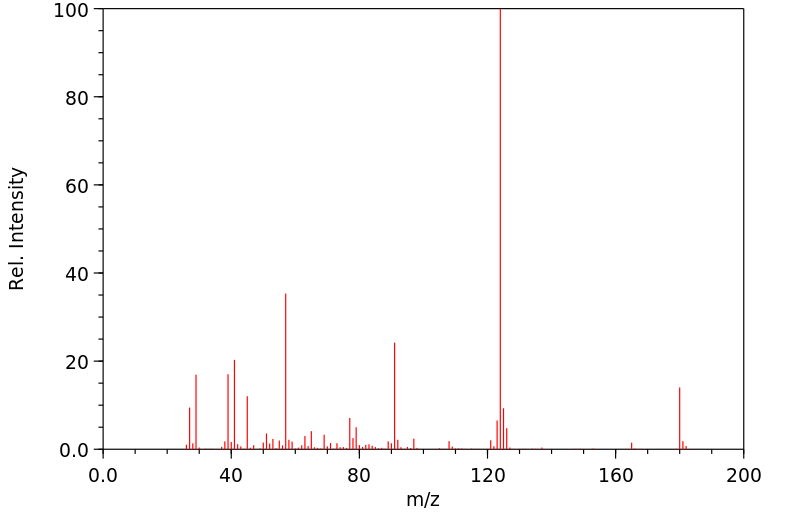1-叔丁基硫基-3-甲基苯 | 34786-26-0
中文名称
1-叔丁基硫基-3-甲基苯
中文别名
——
英文名称
t-Butyl-m-tolylsulfid
英文别名
m-Tolyl-t-butylsulfid;tert-Butyl m-tolyl sulfide;1-tert-butylsulfanyl-3-methylbenzene
CAS
34786-26-0
化学式
C11H16S
mdl
——
分子量
180.314
InChiKey
NOSDQZYLLGTSNW-UHFFFAOYSA-N
BEILSTEIN
——
EINECS
——
-
物化性质
-
计算性质
-
ADMET
-
安全信息
-
SDS
-
制备方法与用途
-
上下游信息
-
文献信息
-
表征谱图
-
同类化合物
-
相关功能分类
-
相关结构分类
物化性质
-
沸点:83 °C(Press: 4 Torr)
-
密度:0.9514 g/cm3
计算性质
-
辛醇/水分配系数(LogP):4.1
-
重原子数:12
-
可旋转键数:2
-
环数:1.0
-
sp3杂化的碳原子比例:0.45
-
拓扑面积:25.3
-
氢给体数:0
-
氢受体数:1
安全信息
-
海关编码:2930909090
反应信息
-
作为产物:描述:参考文献:名称:SNAr nucleophilic substitutions of Cr(CO)3-complexed aryl halides with thiolates under phase-transfer conditions摘要:DOI:10.1021/jo00152a040
文献信息
-
Carbon−Sulfur Bond-Forming Reductive Elimination Involving sp-, sp<sup>2</sup>-, and sp<sup>3</sup>-Hybridized Carbon. Mechanism, Steric Effects, and Electronic Effects on Sulfide Formation作者:Grace Mann、David Baranano、John F. Hartwig、Arnold L. Rheingold、Ilia A. GuzeiDOI:10.1021/ja981428p日期:1998.9.1alkynyl sulfides. Reductive eliminations forming alkenyl alkyl sulfides and aryl alkyl sulfides were the fastest. Eliminations of alkynyl alkyl sulfides were slower, and elimination of dialkyl sulfide was the slowest. Thus the relative rates for sulfide elimination as a function of the hybridization of the palladium-bound carbon follow the trend sp2 > sp ≫ sp3. Rates of reductive elimination were faster钯硫合络合物 [(L)Pd(R)(SR')],其中 L 是螯合配体,例如 DPPE、DPPP、DPPBz、DPPF 或 TRANSPHOS,R 是甲基、烯基、芳基或炔基配体, R'是芳基或烷基,通过取代或质子转移反应合成。发现所有这些硫醇盐配合物都以高产率进行碳硫键形成还原消除,以形成二烷基硫化物、二芳基硫化物、烷基芳基硫化物、烷基烯基硫化物和烷基炔基硫化物。形成烯基烷基硫化物和芳基烷基硫化物的还原消除是最快的。炔基烷基硫化物的消除较慢,二烷基硫化物的消除最慢。因此,作为钯结合碳杂化函数的硫化物消除的相对速率遵循趋势 SP2 > SP ≫ SP3。对于具有较大咬合角的顺式螯合膦配体,还原消除速率更快。动力学研究,以及自由基捕获的结果……
-
Infrared intensities as a quantitative measure of intramolecular interactions. Part XXVIII. Benzenethiols and methyl and t-butyl phenyl sulphides作者:Nigel C. Cutress、T. Bruce Grindley、Alan R. Katritzky、Ronald D. TopsomDOI:10.1039/p29740000263日期:——I.r. intensities of series of meta-substituted benzenethiols and methyl phenyl and phenyl t-butyl sulphides confirm the following order of resonance donation: SMe > SH SBut. The intensities of the para-substituted benzenethiols and phenyl sulphides are interpreted in terms of sulphur d-orbital acceptance when the divalent sulphur opposes a donor substituent. A scale of d-orbital-acceptor ability is
-
TRIAZINE DERIVATIVES AND THEIR THERAPEUTICAL APPLICATIONS申请人:Tao Chunlin公开号:US20120172361A1公开(公告)日:2012-07-05Compounds of the formula (I) and formula (II) and pharmaceutically acceptable salts thereof.公式(I)和公式(II)的化合物及其药学上可接受的盐。
表征谱图
-
氢谱1HNMR
-
质谱MS
-
碳谱13CNMR
-
红外IR
-
拉曼Raman
-
峰位数据
-
峰位匹配
-
表征信息
同类化合物
(Rp)-2-(叔丁硫基)-1-(二苯基膦基)二茂铁
(1E)-1-{4-[(4-氨基苯基)硫烷基]苯基}乙酮肟
颜料红88
颜料紫36
顺式-1,2-二(乙硫基)-1-丙烯
非班太尔-D6
雷西那得中间体
阿西替尼杂质J
阿西替尼杂质C
阿西替尼杂质4
阿西替尼杂质
阿西替尼
阿拉氟韦
阿扎毒素
阿嗪米特
阔草特
银(I)(6-氨基-2-(甲硫基)-5-亚硝基嘧啶-4-基)酰胺水合物
钾三氟[3-(苯基硫基)丙基]硼酸酯(1-)
邻甲苯基(对甲苯基)硫化物
避虫醇
连翘脂苷B
还原红 41
还原紫3
还原桃红R
达索尼兴
辛硫醚
辛-1,7-二炔-1-基(苯基)硫烷
西嗪草酮
萘,2-[(2,3-二甲基苯基)硫代]-
莫他哌那非
茴香硫醚
苯醌B
苯酰胺,N-(氨基亚氨基甲基)-4-[(2-甲基苯基)硫代]-3-(甲磺酰)-,盐酸盐
苯酰胺,N-(氨基亚氨基甲基)-4-[(2-氯苯基)硫代]-3-(甲磺酰)-,盐酸盐
苯酰胺,N-(氨基亚氨基甲基)-4-[(2,6-二氯苯基)硫代]-3-(甲磺酰)-,盐酸盐
苯酰胺,2-[(2-硝基苯基)硫代]-
苯酚,3-氯-4-[(4-硝基苯基)硫代]-
苯酚,3-(乙硫基)-
苯酚,3,5-二[(苯基硫代)甲基]-
苯胺,4-[5-溴-3-[4-(甲硫基)苯基]-2-噻嗯基]-
苯胺,3-氯-4-[(1-甲基-1H-咪唑-2-基)硫代]-
苯胺,2-[(2-吡啶基甲基)硫代]-
苯硫醚-D10
苯硫胍
苯硫基乙酸
苯硫代磺酸S-(三氯乙烯基)酯
苯甲醇,2,3,4,5,6-五氟-a-[(苯基硫代)甲基]-,(R)-
苯甲酸,3-[[2-[(二甲氨基)甲基]苯基]硫代]-,盐酸
苯甲胺,5-氟-2-((3-甲氧苯基)硫代)-N,N-二甲基-,盐酸
苯甲二硫酸,4-溴苯基酯







